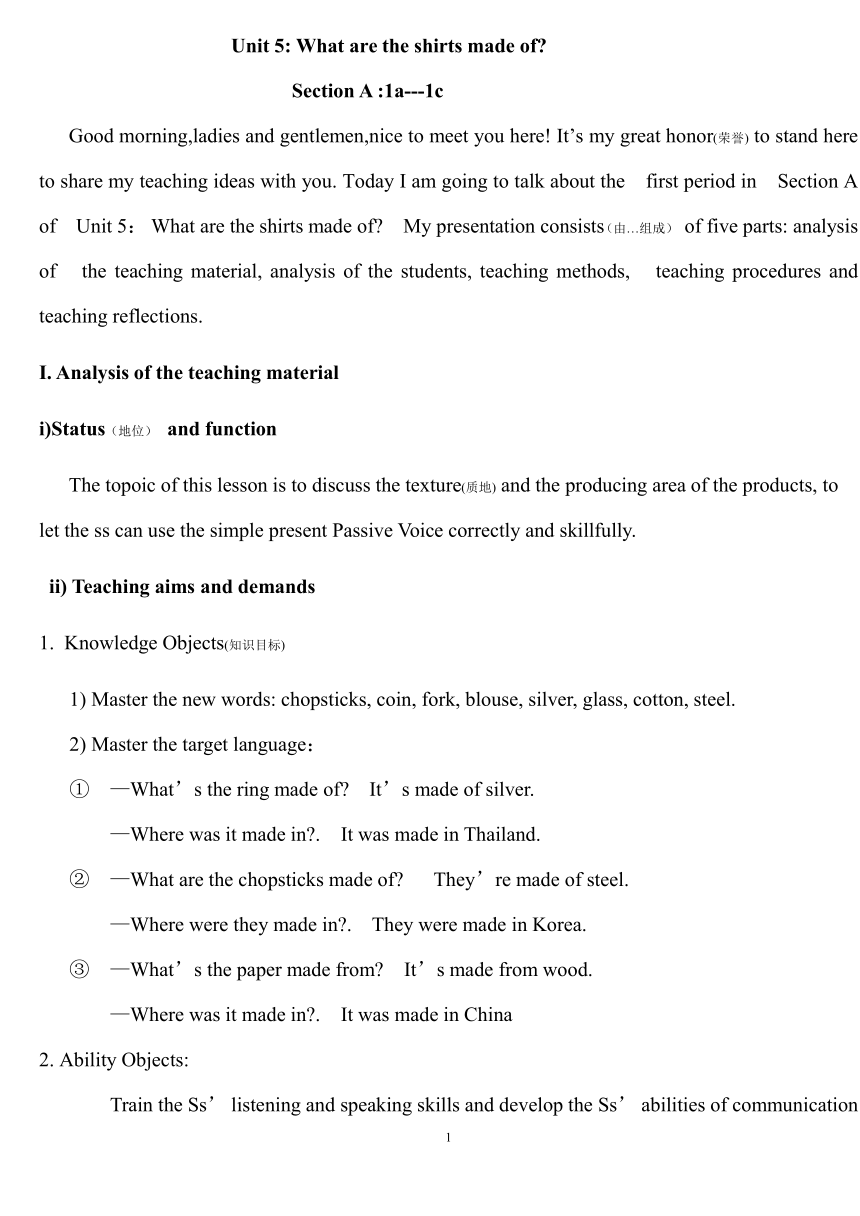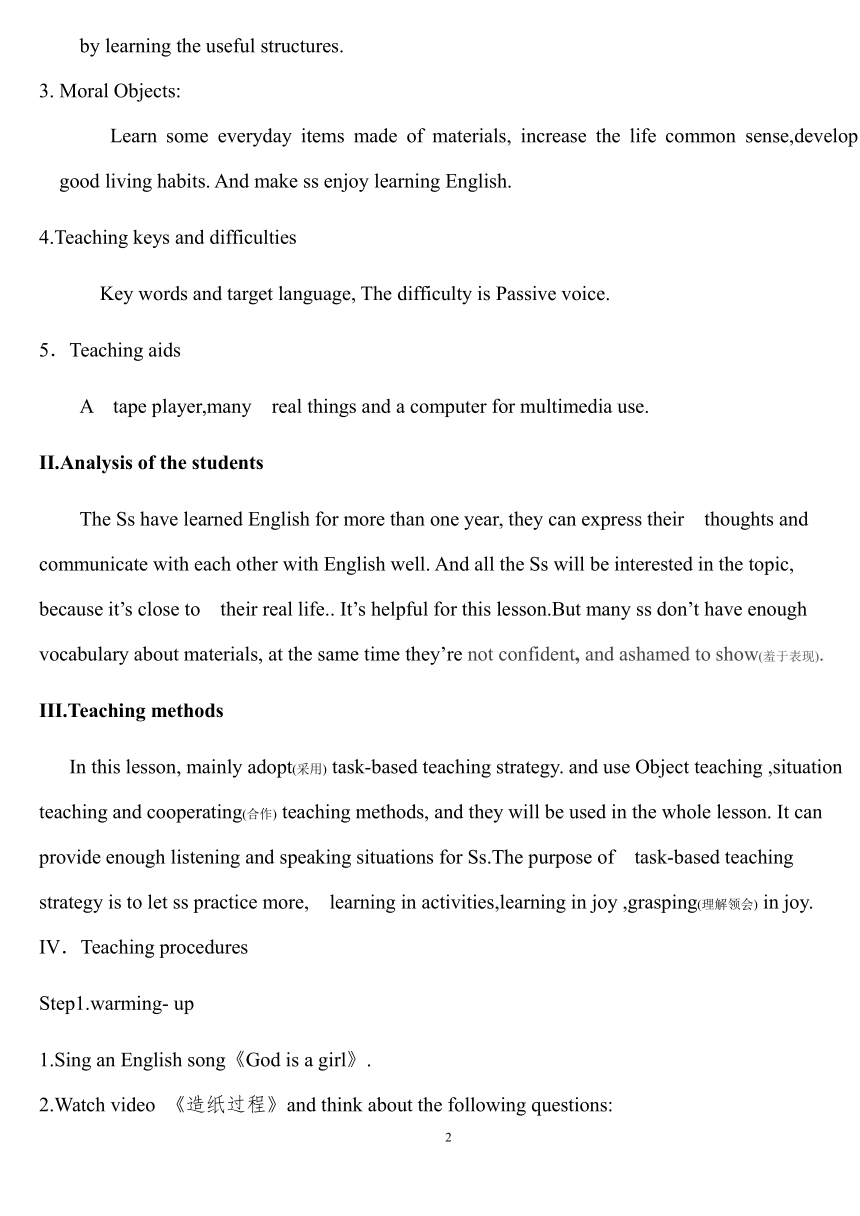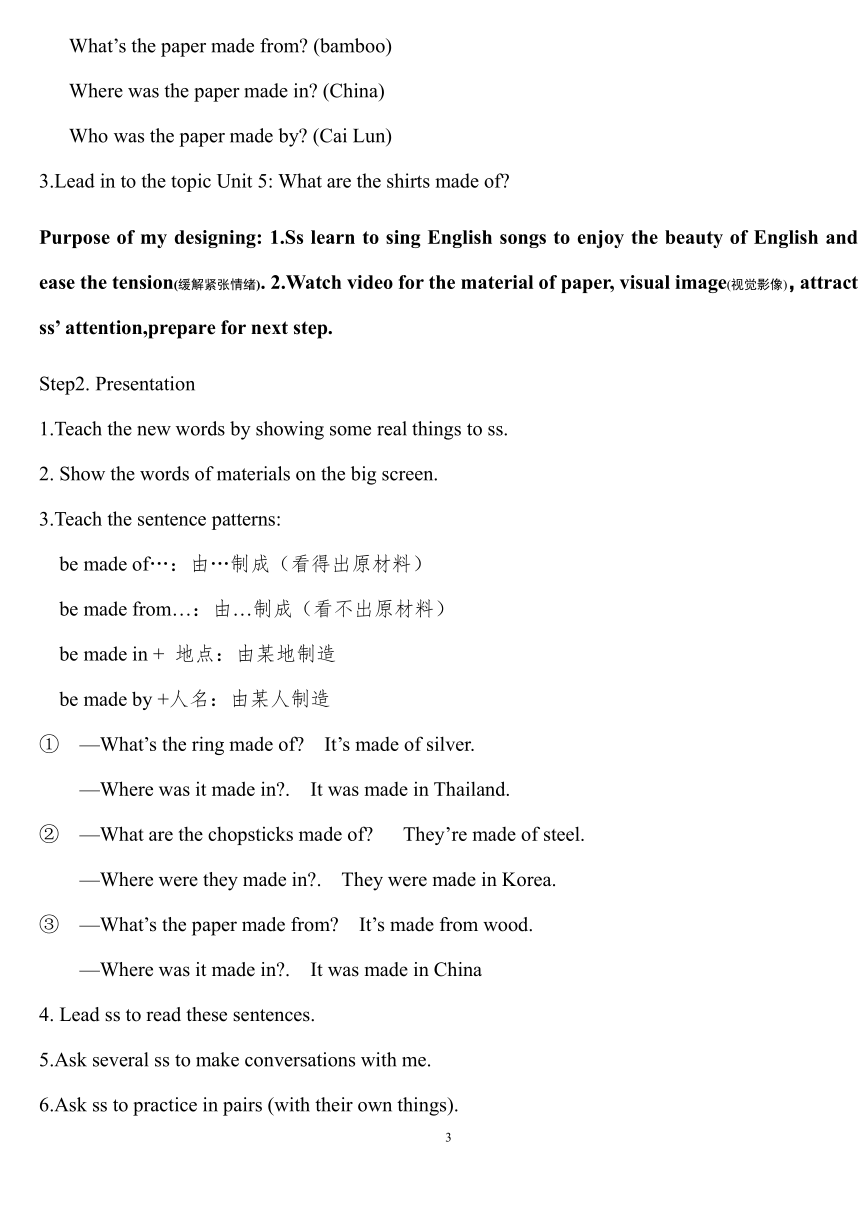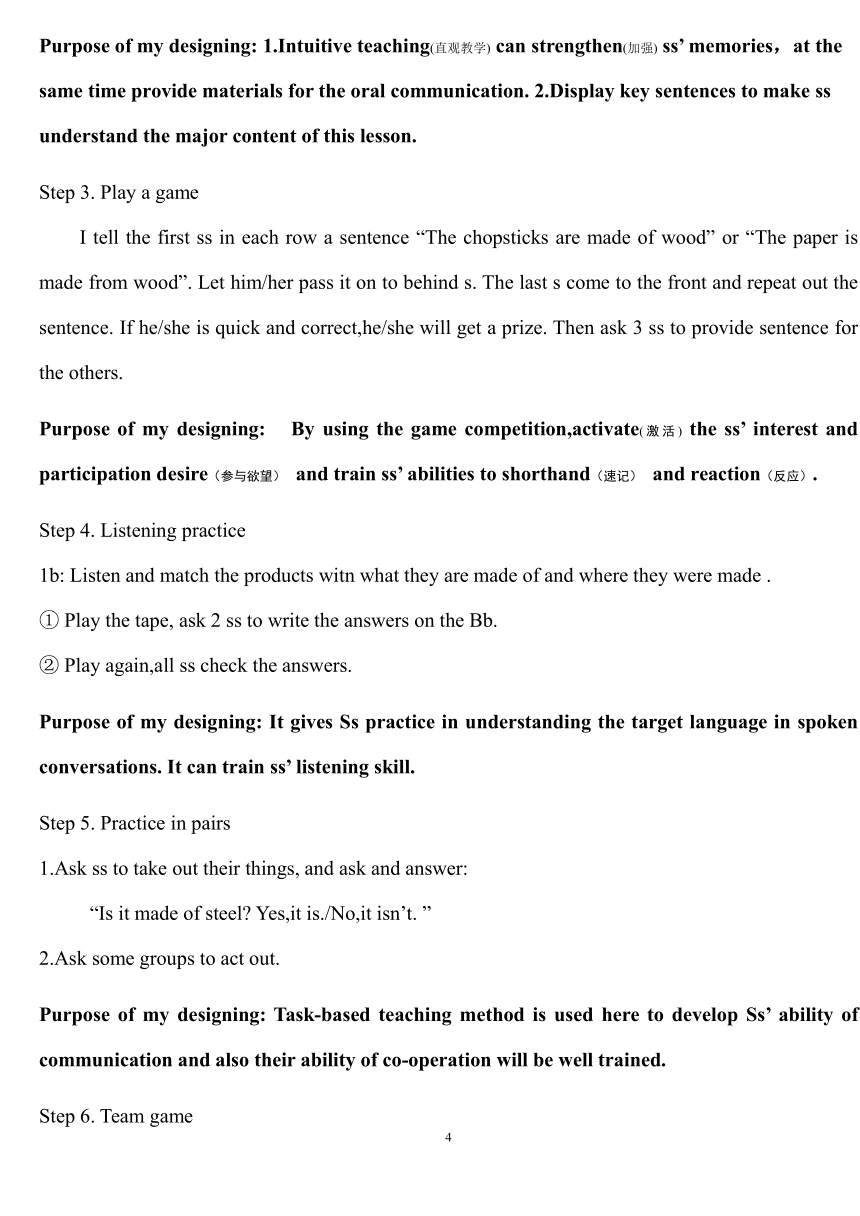人教新目标版英语九年级全Unit 5 What are the shirts made of?Section A 1a-1c&2d & Grammar英文说课稿((2课时)
文档属性
| 名称 | 人教新目标版英语九年级全Unit 5 What are the shirts made of?Section A 1a-1c&2d & Grammar英文说课稿((2课时) |  | |
| 格式 | zip | ||
| 文件大小 | 70.0KB | ||
| 资源类型 | 教案 | ||
| 版本资源 | 人教新目标(Go for it)版 | ||
| 科目 | 英语 | ||
| 更新时间 | 2020-09-19 20:20:13 | ||
图片预览




文档简介
Unit
5:
What
are
the
shirts
made
of?
Section
A
:1a---1c
Good
morning,ladies
and
gentlemen,nice
to
meet
you
here!
It’s
my
great
honor(荣誉)
to
stand
here
to
share
my
teaching
ideas
with
you.
Today
I
am
going
to
talk
about
the
first
period
in
Section
A
of
Unit
5:
What
are
the
shirts
made
of?
My
presentation
consists(由…组成)
of
five
parts:
analysis
of
the
teaching
material,
analysis
of
the
students,
teaching
methods,
teaching
procedures
and
teaching
reflections.
I.
Analysis
of
the
teaching
material
i)Status(地位)
and
function
The
topoic
of
this
lesson
is
to
discuss
the
texture(质地)
and
the
producing
area
of
the
products,
to
let
the
ss
can
use
the
simple
present
Passive
Voice
correctly
and
skillfully.
ii)
Teaching
aims
and
demands
1.??Knowledge
Objects(知识目标)
1)
Master
the
new
words:
chopsticks,
coin,
fork,
blouse,
silver,
glass,
cotton,
steel.
2)
Master
the
target
language:
①
—What’s
the
ring
made
of?
It’s
made
of
silver.
—Where
was
it
made
in?.
It
was
made
in
Thailand.
②
—What
are
the
chopsticks
made
of?
They’re
made
of
steel.
—Where
were
they
made
in?.
They
were
made
in
Korea.
③
—What’s
the
paper
made
from?
It’s
made
from
wood.
—Where
was
it
made
in?.
It
was
made
in
China
2.?Ability
Objects:
Train
the
Ss’
listening
and
speaking
skills
and
develop
the
Ss’
abilities
of
communication
by
learning
the
useful
structures.
3.
Moral
Objects:
Learn
some
everyday
items
made
of
materials,
increase
the
life
common
sense,develop
good
living
habits.
And
make
ss
enjoy
learning
English.
4.Teaching
keys
and
difficulties
Key
words
and
target
language,
The
difficulty
is
Passive
voice.
5.Teaching
aids
A
tape
player,many
real
things
and
a
computer
for
multimedia
use.
II.Analysis
of
the
students
The
Ss
have
learned
English
for
more
than
one
year,
they
can
express
their
thoughts
and
communicate
with
each
other
with
English
well.
And
all
the
Ss
will
be
interested
in
the
topic,
because
it’s
close
to
their
real
life..
It’s
helpful
for
this
lesson.But
many
ss
don’t
have
enough
vocabulary
about
materials,
at
the
same
time
they’re
not
confident,
and
ashamed
to
show(羞于表现).
III.Teaching
methods
In
this
lesson,
mainly
adopt(采用)
task-based
teaching
strategy.
and
use
Object
teaching
,situation
teaching
and
cooperating(合作)
teaching
methods,
and
they
will
be
used
in
the
whole
lesson.
It
can
provide
enough
listening
and
speaking
situations
for
Ss.The
purpose
of
task-based
teaching
strategy
is
to
let
ss
practice
more,
learning
in
activities,learning
in
joy
,grasping(理解领会)
in
joy.
IV.Teaching
procedures
Step1.warming-
up
1.Sing
an
English
song《God
is
a
girl》.
2.Watch
video
《造纸过程》and
think
about
the
following
questions:
What’s
the
paper
made
from?
(bamboo)
Where
was
the
paper
made
in?
(China)
Who
was
the
paper
made
by?
(Cai
Lun)
3.Lead
in
to
the
topic
Unit
5:
What
are
the
shirts
made
of?
Purpose
of
my
designing:
1.Ss
learn
to
sing
English
songs
to
enjoy
the
beauty
of
English
and
ease
the
tension(缓解紧张情绪).
2.Watch
video
for
the
material
of
paper,
visual
image(视觉影像),attract
ss’
attention,prepare
for
next
step.
Step2.
Presentation
1.Teach
the
new
words
by
showing
some
real
things
to
ss.
2.
Show
the
words
of
materials
on
the
big
screen.
3.Teach
the
sentence
patterns:
be
made
of…:由…制成(看得出原材料)
be
made
from…:由…制成(看不出原材料)
be
made
in
+
地点:由某地制造
be
made
by
+人名:由某人制造
①
—What’s
the
ring
made
of?
It’s
made
of
silver.
—Where
was
it
made
in?.
It
was
made
in
Thailand.
②
—What
are
the
chopsticks
made
of?
They’re
made
of
steel.
—Where
were
they
made
in?.
They
were
made
in
Korea.
③
—What’s
the
paper
made
from?
It’s
made
from
wood.
—Where
was
it
made
in?.
It
was
made
in
China
4.
Lead
ss
to
read
these
sentences.
5.Ask
several
ss
to
make
conversations
with
me.
6.Ask
ss
to
practice
in
pairs
(with
their
own
things).
Purpose
of
my
designing:
1.Intuitive
teaching(直观教学)
can
strengthen(加强)
ss’
memories,at
the
same
time
provide
materials
for
the
oral
communication.
2.Display
key
sentences
to
make
ss
understand
the
major
content
of
this
lesson.
Step
3.
Play
a
game
I
tell
the
first
ss
in
each
row
a
sentence
“The
chopsticks
are
made
of
wood”
or
“The
paper
is
made
from
wood”.
Let
him/her
pass
it
on
to
behind
s.
The
last
s
come
to
the
front
and
repeat
out
the
sentence.
If
he/she
is
quick
and
correct,he/she
will
get
a
prize.
Then
ask
3
ss
to
provide
sentence
for
the
others.
Purpose
of
my
designing:
By
using
the
game
competition,activate(激活)
the
ss’
interest
and
participation
desire(参与欲望)
and
train
ss’
abilities
to
shorthand(速记)
and
reaction(反应).
Step
4.
Listening
practice
1b:
Listen
and
match
the
products
witn
what
they
are
made
of
and
where
they
were
made
.
①
Play
the
tape,
ask
2
ss
to
write
the
answers
on
the
Bb.
②
Play
again,all
ss
check
the
answers.
Purpose
of
my
designing:
It
gives
Ss
practice
in
understanding
the
target
language
in
spoken
conversations.
It
can
train
ss’
listening
skill.
Step
5.
Practice
in
pairs
1.Ask
ss
to
take
out
their
things,
and
ask
and
answer:
“Is
it
made
of
steel?
Yes,it
is./No,it
isn’t.
”
2.Ask
some
groups
to
act
out.
Purpose
of
my
designing:
Task-based
teaching
method
is
used
here
to
develop
Ss’
ability
of
communication
and
also
their
ability
of
co-operation
will
be
well
trained.
Step
6.
Team
game
Judge
the
10
sentences
right
or
wrong
according
to
the
text,say
“Yes”
or
“No”.
①Susan
bought
three
shirts
for
39
dollars
yesterday.(
×
)
②Susan’s
shirts
are
made
of
cotton.(
√
)
③Susan’s
shirts
were
made
in
Australia.(
×
)
④Anita
thinks
Susan’s
shirts
are
really
cool.(
√
)
⑤Susan
got
the
chopsticks
in
Korea.(
√
)
⑥Anita
has
seen
steel
chopsticks
before.(
×
)
⑦Steel
chopsticks
are
not
popular
in
Korea.(
×
)
⑧Anita
thinks
the
ring
is
quite
pretty.(
√
)
⑨The
ring
was
not
made
in
Thailand.(
×
)
⑩Susan
will
give
the
ring
to
her
mother.(
×
)
Purpose
of
my
designing:
Through
the
group
activities,make
ss
understand
listening
content
deeply,
and
train
ss’
listening
,comprehension(理解领会)
and
reaction
skills.
Step
7.
Summarize
被动语态:be
+
done
(助动词+动词的过去分词)
The
paper
is
made
from
wood.
It
was
made
in
China.
Chopsticks
are
made
of
steel.
They
were
made
in
Korea.
Purpose
of
my
designing:
Sum
up
to
make
ss
know
what
they
have
learned
in
this
lesson.
Step
8.
Homework
Choose
your
6
things
to
write
a
passage
with
the
structure
:
“____
is/are
made
of/from….
It
was/They
were
made
in…
It
was/They
were
made
by…”
Purpose
of
my
designing:
Consolidate(巩固)
knowledge
by
the
homework,
trianing
ss’
writing
skill.
Step9.
Blackboard
design
Unit
5:
What
are
the
shirts
made
of?Section
A
1a---1c一.
be
made
of…:由…制成(看得出原材料)
be
made
from…:由…制成(看不出原材料)be
made
in
+
地点:由某地制造be
made
by
+人名:由某人制造二.被动语态:be(助动词)
+
done(动词的过去分词)
The
paper
is
made
from
wood.It
was
made
in
China.It
was
made
by
Cai
Lun.Chopsticks
are
made
of
steel.They
were
made
in
Korea.They
were
made
by
Chinese.
Step10.
Teaching
reflections.
优点:1.根据我校初三学生的英语现状(基础差,参差不齐)和新知学习规律(由易到难,有少至多),
将本课内容确定为Section
A
1a---1c,落实课堂实效,争取当堂消化。
2.由“造纸过程”的视频引出被动语态be
made
of…及本课主题,能够吸引学生兴趣。
3.实物教学使学生感受真实情境,提供了开口说的材料使学生有话可说。
4.活动设计多样学生参与率高,有利于激发学生对英语的兴趣。以任务型教学策略为主,采用情景教学法、听力训练法、并辅助个人自学、小组讨论和比赛竞争等兴趣策略教学。采取任务型教学策略的目的是主要是让学生多练多用,在做中学、学中乐、乐中掌握
5.作业部分的写作是本课目标语言的巩固,也是写作能力的训练。
缺点:1.学生有胆怯心理害怕犯错误。
2.新词汇掌握不熟影响应用。
Unit
5
?
What
are
the
shirts
made
of
?
Section
A
2d
&
Grammar(说课稿)
?
?
?
?
?
?
?
?
?
?
?
?
?
?
?
?
?
?
?
?
一、教材分析
1、教学内容:?
?
?
本节教学内容为人教版英语Book
9
Unit
5,话题为讨论物品的质地和产地,围绕各国传统文化元素展开,主要是让学生能够正确熟练地使用被动语态来谈论物品质地和产地的历史,通过本节课的学习,学生需要了解中国茶的种植和制造过程,从而增强爱国荣誉感,并从中感知一般现在时的被动语态,学会熟练、正确地使用被动语态去描述物品的制造过程。
2、教材的地位和作用:
本节课内容中的被动语态,是中考的一个重点,也是难点,根据英语课程标准要求“能够灵活运用英语去做事情”,学生必须通过学习能够正确地运用本单元所学的被动语态,去描述物品的质地、产地及制造过程,从而达到学以致用的目的。
二、说教学目标:
?
?
依据初中英语新课标的要求,我为本课确定了三项教学目标:?
?
?
知识:能够熟练运用目标句型描述物品的材质、产地等信息
?
?
?
?
?
了解中国茶的种植和制造过程,并能够简单叙述
?
?
?
?
?
熟练掌握一般现在时的被动语态,并能正确运用
?
?
能力:能够熟练讨论物品的质地、产地及制造过程
?
?
情感:了解中国的传统文化元素,增强爱国荣誉感,激发学生了解各国传统文化的兴趣。
三、说教学重难点
?
?
根据教学大纲要求,教材编排特点,并从学生的实际出发,我将本课的重点与难点确定为:
?
?
熟练掌握一般现在时的被动语态,并能正确运用
四、说教法和学法:?
?
?
1、教法分析:
?
?
基于新课标要求要发挥学生的主体性,鼓励学生用自主、合作和探究的方式进行学习的理念,我将采用以下教学方法:
?
?
(1)引导感知:采用略读与精读相结合的方式,锻炼和培养学生的阅读能力,促使其感知被动语态在描述物品时的重要性。
?
?
(2)归纳点拨:通过读句子,寻找归纳的突破口,激励学生参与学习、自主学习,可以更好地理解和加深学习印象。
?
?
(3)测试检验:鉴于所有学习任务均通过自学方式完成,所以检测关很重要,我改变了做与核对的方式,采用做看改的方式,是学生从别人的错误中去认真辨析,锻炼了学生的自信心。
?
?
2、学法分析:?
?
?
(1)自主讲解法:为了鼓励学生课前自主查阅资料,特意在上一节课留下作业:区分短语的用法,通过自主讲解的形式,鼓励学生参与并展示,充分锻炼学生的自主能力和自学能力。
?
?
(2)阅读训练法:对于2d部分的小对话,我采用了先阅读再朗读的方式进行教学,一是为了锻炼和培养学生的阅读能力,二是为了下一环节学习被动语态做铺垫,通过阅读基本能够体会到被动语态在描述中的重要性。
?
?
(3)规则归纳法:通过对已学句子的分析,归纳出被动语态的基本结构,使学生充分了解其结构特点,同时学习印象也更深刻。
?
?
(4)自学释疑法:通过自学与交流的方式明确语法重点,接力学生自主学习知识,使其学会自主学习。
?
?
五、说教学过程
?
?
经过以上对教情,学情的分析,我将本课的教学过程设计为以下六大环节。
(一)Say
and
do(课前检测)
?
?
1、说说我知道(说出下列短语的区别)
(设计意图:通过课前检测,既检测了课下自学效果,又能很好地区分和学习各个短语的用法。)
?
?
2、做做我能行(用合适的介词填空)
(设计意图:检测学习效果,夯实基础。)
(二)Self-study(自学)
??
Task
1:
Reading
practice(阅读训练)
?
?
1、自主阅读2d对话并完成表格
?
?
(设计意图:略读填空,锻炼学生的阅读速度,和在读中抓关键词的能力。)
?
?
2、再读对话,判断正误(T
or
F)
?
?
(设计意图:精读,寻找出错点,培养精读能力,也提示学生,阅读理解时要关注细节。)
?
?
?3、小组交流,核查更正
?
?
?4、分角色朗读对话
?
?
(设计意图:对话练习,在读中感知语法,也对茶文化的了解进一步加深,为复述和描述其他物品打好了基础。)
?
Task
2:Grammar
Focus(语法聚焦)
?
?
1、读句子找规律(表格中加粗的句子)
?
?
(设计意图:归纳规则,锻炼自主学习能力。)
?
?
2、自主学习一般现在时的被动语态
?
?
(设计意图:自学语法,通过自学,学生的印象更加深刻。)
(三)Explain
the
difficulties(小组交流、释疑,记忆要点。)
?
?(设计意图:教师点拨,针对要点点拨提示,避免运用出错。)
(四)Practice
and
test(练习与检测)
?
?
1、动词过去式和过去分词练习
?
?
2、单项选择
?
?
3、用动词的正确语态填空
?
?
(设计意图:通过形式变化练习,使学生先对简单的过去分词进行复习,化解下一部分的阅读文章中的难度。再通过由浅入深的练习,锻炼学生的解题能力,检测所学内容的运用情况,反馈学习难点,解疑化难。)
PAGE
6
5:
What
are
the
shirts
made
of?
Section
A
:1a---1c
Good
morning,ladies
and
gentlemen,nice
to
meet
you
here!
It’s
my
great
honor(荣誉)
to
stand
here
to
share
my
teaching
ideas
with
you.
Today
I
am
going
to
talk
about
the
first
period
in
Section
A
of
Unit
5:
What
are
the
shirts
made
of?
My
presentation
consists(由…组成)
of
five
parts:
analysis
of
the
teaching
material,
analysis
of
the
students,
teaching
methods,
teaching
procedures
and
teaching
reflections.
I.
Analysis
of
the
teaching
material
i)Status(地位)
and
function
The
topoic
of
this
lesson
is
to
discuss
the
texture(质地)
and
the
producing
area
of
the
products,
to
let
the
ss
can
use
the
simple
present
Passive
Voice
correctly
and
skillfully.
ii)
Teaching
aims
and
demands
1.??Knowledge
Objects(知识目标)
1)
Master
the
new
words:
chopsticks,
coin,
fork,
blouse,
silver,
glass,
cotton,
steel.
2)
Master
the
target
language:
①
—What’s
the
ring
made
of?
It’s
made
of
silver.
—Where
was
it
made
in?.
It
was
made
in
Thailand.
②
—What
are
the
chopsticks
made
of?
They’re
made
of
steel.
—Where
were
they
made
in?.
They
were
made
in
Korea.
③
—What’s
the
paper
made
from?
It’s
made
from
wood.
—Where
was
it
made
in?.
It
was
made
in
China
2.?Ability
Objects:
Train
the
Ss’
listening
and
speaking
skills
and
develop
the
Ss’
abilities
of
communication
by
learning
the
useful
structures.
3.
Moral
Objects:
Learn
some
everyday
items
made
of
materials,
increase
the
life
common
sense,develop
good
living
habits.
And
make
ss
enjoy
learning
English.
4.Teaching
keys
and
difficulties
Key
words
and
target
language,
The
difficulty
is
Passive
voice.
5.Teaching
aids
A
tape
player,many
real
things
and
a
computer
for
multimedia
use.
II.Analysis
of
the
students
The
Ss
have
learned
English
for
more
than
one
year,
they
can
express
their
thoughts
and
communicate
with
each
other
with
English
well.
And
all
the
Ss
will
be
interested
in
the
topic,
because
it’s
close
to
their
real
life..
It’s
helpful
for
this
lesson.But
many
ss
don’t
have
enough
vocabulary
about
materials,
at
the
same
time
they’re
not
confident,
and
ashamed
to
show(羞于表现).
III.Teaching
methods
In
this
lesson,
mainly
adopt(采用)
task-based
teaching
strategy.
and
use
Object
teaching
,situation
teaching
and
cooperating(合作)
teaching
methods,
and
they
will
be
used
in
the
whole
lesson.
It
can
provide
enough
listening
and
speaking
situations
for
Ss.The
purpose
of
task-based
teaching
strategy
is
to
let
ss
practice
more,
learning
in
activities,learning
in
joy
,grasping(理解领会)
in
joy.
IV.Teaching
procedures
Step1.warming-
up
1.Sing
an
English
song《God
is
a
girl》.
2.Watch
video
《造纸过程》and
think
about
the
following
questions:
What’s
the
paper
made
from?
(bamboo)
Where
was
the
paper
made
in?
(China)
Who
was
the
paper
made
by?
(Cai
Lun)
3.Lead
in
to
the
topic
Unit
5:
What
are
the
shirts
made
of?
Purpose
of
my
designing:
1.Ss
learn
to
sing
English
songs
to
enjoy
the
beauty
of
English
and
ease
the
tension(缓解紧张情绪).
2.Watch
video
for
the
material
of
paper,
visual
image(视觉影像),attract
ss’
attention,prepare
for
next
step.
Step2.
Presentation
1.Teach
the
new
words
by
showing
some
real
things
to
ss.
2.
Show
the
words
of
materials
on
the
big
screen.
3.Teach
the
sentence
patterns:
be
made
of…:由…制成(看得出原材料)
be
made
from…:由…制成(看不出原材料)
be
made
in
+
地点:由某地制造
be
made
by
+人名:由某人制造
①
—What’s
the
ring
made
of?
It’s
made
of
silver.
—Where
was
it
made
in?.
It
was
made
in
Thailand.
②
—What
are
the
chopsticks
made
of?
They’re
made
of
steel.
—Where
were
they
made
in?.
They
were
made
in
Korea.
③
—What’s
the
paper
made
from?
It’s
made
from
wood.
—Where
was
it
made
in?.
It
was
made
in
China
4.
Lead
ss
to
read
these
sentences.
5.Ask
several
ss
to
make
conversations
with
me.
6.Ask
ss
to
practice
in
pairs
(with
their
own
things).
Purpose
of
my
designing:
1.Intuitive
teaching(直观教学)
can
strengthen(加强)
ss’
memories,at
the
same
time
provide
materials
for
the
oral
communication.
2.Display
key
sentences
to
make
ss
understand
the
major
content
of
this
lesson.
Step
3.
Play
a
game
I
tell
the
first
ss
in
each
row
a
sentence
“The
chopsticks
are
made
of
wood”
or
“The
paper
is
made
from
wood”.
Let
him/her
pass
it
on
to
behind
s.
The
last
s
come
to
the
front
and
repeat
out
the
sentence.
If
he/she
is
quick
and
correct,he/she
will
get
a
prize.
Then
ask
3
ss
to
provide
sentence
for
the
others.
Purpose
of
my
designing:
By
using
the
game
competition,activate(激活)
the
ss’
interest
and
participation
desire(参与欲望)
and
train
ss’
abilities
to
shorthand(速记)
and
reaction(反应).
Step
4.
Listening
practice
1b:
Listen
and
match
the
products
witn
what
they
are
made
of
and
where
they
were
made
.
①
Play
the
tape,
ask
2
ss
to
write
the
answers
on
the
Bb.
②
Play
again,all
ss
check
the
answers.
Purpose
of
my
designing:
It
gives
Ss
practice
in
understanding
the
target
language
in
spoken
conversations.
It
can
train
ss’
listening
skill.
Step
5.
Practice
in
pairs
1.Ask
ss
to
take
out
their
things,
and
ask
and
answer:
“Is
it
made
of
steel?
Yes,it
is./No,it
isn’t.
”
2.Ask
some
groups
to
act
out.
Purpose
of
my
designing:
Task-based
teaching
method
is
used
here
to
develop
Ss’
ability
of
communication
and
also
their
ability
of
co-operation
will
be
well
trained.
Step
6.
Team
game
Judge
the
10
sentences
right
or
wrong
according
to
the
text,say
“Yes”
or
“No”.
①Susan
bought
three
shirts
for
39
dollars
yesterday.(
×
)
②Susan’s
shirts
are
made
of
cotton.(
√
)
③Susan’s
shirts
were
made
in
Australia.(
×
)
④Anita
thinks
Susan’s
shirts
are
really
cool.(
√
)
⑤Susan
got
the
chopsticks
in
Korea.(
√
)
⑥Anita
has
seen
steel
chopsticks
before.(
×
)
⑦Steel
chopsticks
are
not
popular
in
Korea.(
×
)
⑧Anita
thinks
the
ring
is
quite
pretty.(
√
)
⑨The
ring
was
not
made
in
Thailand.(
×
)
⑩Susan
will
give
the
ring
to
her
mother.(
×
)
Purpose
of
my
designing:
Through
the
group
activities,make
ss
understand
listening
content
deeply,
and
train
ss’
listening
,comprehension(理解领会)
and
reaction
skills.
Step
7.
Summarize
被动语态:be
+
done
(助动词+动词的过去分词)
The
paper
is
made
from
wood.
It
was
made
in
China.
Chopsticks
are
made
of
steel.
They
were
made
in
Korea.
Purpose
of
my
designing:
Sum
up
to
make
ss
know
what
they
have
learned
in
this
lesson.
Step
8.
Homework
Choose
your
6
things
to
write
a
passage
with
the
structure
:
“____
is/are
made
of/from….
It
was/They
were
made
in…
It
was/They
were
made
by…”
Purpose
of
my
designing:
Consolidate(巩固)
knowledge
by
the
homework,
trianing
ss’
writing
skill.
Step9.
Blackboard
design
Unit
5:
What
are
the
shirts
made
of?Section
A
1a---1c一.
be
made
of…:由…制成(看得出原材料)
be
made
from…:由…制成(看不出原材料)be
made
in
+
地点:由某地制造be
made
by
+人名:由某人制造二.被动语态:be(助动词)
+
done(动词的过去分词)
The
paper
is
made
from
wood.It
was
made
in
China.It
was
made
by
Cai
Lun.Chopsticks
are
made
of
steel.They
were
made
in
Korea.They
were
made
by
Chinese.
Step10.
Teaching
reflections.
优点:1.根据我校初三学生的英语现状(基础差,参差不齐)和新知学习规律(由易到难,有少至多),
将本课内容确定为Section
A
1a---1c,落实课堂实效,争取当堂消化。
2.由“造纸过程”的视频引出被动语态be
made
of…及本课主题,能够吸引学生兴趣。
3.实物教学使学生感受真实情境,提供了开口说的材料使学生有话可说。
4.活动设计多样学生参与率高,有利于激发学生对英语的兴趣。以任务型教学策略为主,采用情景教学法、听力训练法、并辅助个人自学、小组讨论和比赛竞争等兴趣策略教学。采取任务型教学策略的目的是主要是让学生多练多用,在做中学、学中乐、乐中掌握
5.作业部分的写作是本课目标语言的巩固,也是写作能力的训练。
缺点:1.学生有胆怯心理害怕犯错误。
2.新词汇掌握不熟影响应用。
Unit
5
?
What
are
the
shirts
made
of
?
Section
A
2d
&
Grammar(说课稿)
?
?
?
?
?
?
?
?
?
?
?
?
?
?
?
?
?
?
?
?
一、教材分析
1、教学内容:?
?
?
本节教学内容为人教版英语Book
9
Unit
5,话题为讨论物品的质地和产地,围绕各国传统文化元素展开,主要是让学生能够正确熟练地使用被动语态来谈论物品质地和产地的历史,通过本节课的学习,学生需要了解中国茶的种植和制造过程,从而增强爱国荣誉感,并从中感知一般现在时的被动语态,学会熟练、正确地使用被动语态去描述物品的制造过程。
2、教材的地位和作用:
本节课内容中的被动语态,是中考的一个重点,也是难点,根据英语课程标准要求“能够灵活运用英语去做事情”,学生必须通过学习能够正确地运用本单元所学的被动语态,去描述物品的质地、产地及制造过程,从而达到学以致用的目的。
二、说教学目标:
?
?
依据初中英语新课标的要求,我为本课确定了三项教学目标:?
?
?
知识:能够熟练运用目标句型描述物品的材质、产地等信息
?
?
?
?
?
了解中国茶的种植和制造过程,并能够简单叙述
?
?
?
?
?
熟练掌握一般现在时的被动语态,并能正确运用
?
?
能力:能够熟练讨论物品的质地、产地及制造过程
?
?
情感:了解中国的传统文化元素,增强爱国荣誉感,激发学生了解各国传统文化的兴趣。
三、说教学重难点
?
?
根据教学大纲要求,教材编排特点,并从学生的实际出发,我将本课的重点与难点确定为:
?
?
熟练掌握一般现在时的被动语态,并能正确运用
四、说教法和学法:?
?
?
1、教法分析:
?
?
基于新课标要求要发挥学生的主体性,鼓励学生用自主、合作和探究的方式进行学习的理念,我将采用以下教学方法:
?
?
(1)引导感知:采用略读与精读相结合的方式,锻炼和培养学生的阅读能力,促使其感知被动语态在描述物品时的重要性。
?
?
(2)归纳点拨:通过读句子,寻找归纳的突破口,激励学生参与学习、自主学习,可以更好地理解和加深学习印象。
?
?
(3)测试检验:鉴于所有学习任务均通过自学方式完成,所以检测关很重要,我改变了做与核对的方式,采用做看改的方式,是学生从别人的错误中去认真辨析,锻炼了学生的自信心。
?
?
2、学法分析:?
?
?
(1)自主讲解法:为了鼓励学生课前自主查阅资料,特意在上一节课留下作业:区分短语的用法,通过自主讲解的形式,鼓励学生参与并展示,充分锻炼学生的自主能力和自学能力。
?
?
(2)阅读训练法:对于2d部分的小对话,我采用了先阅读再朗读的方式进行教学,一是为了锻炼和培养学生的阅读能力,二是为了下一环节学习被动语态做铺垫,通过阅读基本能够体会到被动语态在描述中的重要性。
?
?
(3)规则归纳法:通过对已学句子的分析,归纳出被动语态的基本结构,使学生充分了解其结构特点,同时学习印象也更深刻。
?
?
(4)自学释疑法:通过自学与交流的方式明确语法重点,接力学生自主学习知识,使其学会自主学习。
?
?
五、说教学过程
?
?
经过以上对教情,学情的分析,我将本课的教学过程设计为以下六大环节。
(一)Say
and
do(课前检测)
?
?
1、说说我知道(说出下列短语的区别)
(设计意图:通过课前检测,既检测了课下自学效果,又能很好地区分和学习各个短语的用法。)
?
?
2、做做我能行(用合适的介词填空)
(设计意图:检测学习效果,夯实基础。)
(二)Self-study(自学)
??
Task
1:
Reading
practice(阅读训练)
?
?
1、自主阅读2d对话并完成表格
?
?
(设计意图:略读填空,锻炼学生的阅读速度,和在读中抓关键词的能力。)
?
?
2、再读对话,判断正误(T
or
F)
?
?
(设计意图:精读,寻找出错点,培养精读能力,也提示学生,阅读理解时要关注细节。)
?
?
?3、小组交流,核查更正
?
?
?4、分角色朗读对话
?
?
(设计意图:对话练习,在读中感知语法,也对茶文化的了解进一步加深,为复述和描述其他物品打好了基础。)
?
Task
2:Grammar
Focus(语法聚焦)
?
?
1、读句子找规律(表格中加粗的句子)
?
?
(设计意图:归纳规则,锻炼自主学习能力。)
?
?
2、自主学习一般现在时的被动语态
?
?
(设计意图:自学语法,通过自学,学生的印象更加深刻。)
(三)Explain
the
difficulties(小组交流、释疑,记忆要点。)
?
?(设计意图:教师点拨,针对要点点拨提示,避免运用出错。)
(四)Practice
and
test(练习与检测)
?
?
1、动词过去式和过去分词练习
?
?
2、单项选择
?
?
3、用动词的正确语态填空
?
?
(设计意图:通过形式变化练习,使学生先对简单的过去分词进行复习,化解下一部分的阅读文章中的难度。再通过由浅入深的练习,锻炼学生的解题能力,检测所学内容的运用情况,反馈学习难点,解疑化难。)
PAGE
6
同课章节目录
- Unit 1 How can we become good learners.
- Section A
- Section B
- Unit 2 I think that mooncakes are delicious!
- Section A
- Section B
- Unit 3 Could you please tell me where the restroom
- Section A
- Section B
- Unit 4 I used to be afraid of the dark.
- Section A
- Section B
- Unit 5 What are the shirts made of?
- Section A
- Section B
- Review of Units 1-5
- Unit 6 When was it invented?
- Section A
- Section B
- Unit 7 Teenagers should be allowed to choose their
- Section A
- Section B
- Unit 8 It must belong to Carla.
- Section A
- Section B
- Unit 9 I like music that I can dance to.
- Section A
- Section B
- Unit 10 You're supposed to shake hands.
- Section A
- Section B
- Review of Units 6-10
- Unit 11 Sad movies make me cry.
- Section A
- Section B
- Unit 12 Life is full of the unexpected
- Section A
- Section B
- Unit 13 We're trying to save the earth!
- Section A
- Section B
- Unit 14 I remember meeting all of you in Grade 7.
- Section A
- Section B
- Review of Units 11-14
